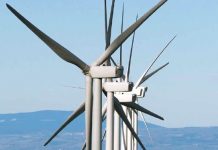Every year news is made at the WINDPOWER Conference & Exhibition, and that was as true as ever this time around. If you were at WINDPOWER 2014, which happened May 5-8 in Las Vegas, Nev., hopefully you took in much of the news, not to mention got a little business done and perhaps even socialized with some of the nearly 8,000 other participants.
But organizing the massive amount of information and happenings that come participants’ way during North America’s largest wind industry gathering can be tough. So for both those who were in Vegas and those who couldn’t make it, here are three key industry developments and takeaways from WINDPOWER 2014.
New Wind Vision
The U.S. Department of Energy (DOE) shared details for the first time of its Wind Vision initiative, launched last year at WINDPOWER. The key benchmarks announced: 10 percent wind energy on the U.S. power grid by 2020; 20 percent by 2030; and 35 percent by 2050.
More than doubling wind’s penetration from 4 percent to 10 percent by 2020 will require as much growth in the next six years as the past 40. Jose Zayas, Director of the Wind and Water Power Technologies Office at DOE, outlined the benefits: $520 billion saved for electric consumers between now and 2050 (when electricity will cost 3 percent less than it otherwise would); 336 billion gallons of water saved by 2050; 140,000 industry jobs by 2020 and 400,000 jobs by 2050, plus spinoff jobs benefits.
The Wind Vision calls for approximately 10,000 MW a year to be deployed over the next several years, including substantial offshore wind starting to come online by the latter part of this decade.
Wind as Leading Solution to Climate Change
With recent reports underscoring the urgency of tackling climate change, industry leadership underscored its readiness to be a top solution. “The urgent need to dramatically reduce global carbon emissions brings incredible opportunity to our industry,” said Susan Reilly, CEO of RES Americas, and new Chair of the AWEA Board of Directors.
Forty percent of all carbon emissions in the U.S. come from the electric power sector. Scientists say “decarbonizing” electricity is critical to holding carbon dioxide to a safer level in the atmosphere, and avoiding the worst impacts of climate change cost effectively, Reilly said.
“The facts are clear: After energy efficiency, wind energy is the fastest, cheapest way to get the biggest carbon reductions in our energy portfolio,” Reilly said. “So wind energy is no longer an ‘alternative’—it is an imperative.”
DOE Advances Three Demo Offshore Projects
DOE announced the three winning offshore projects for Phase 2 of its Advanced Technology Demonstration Project Initiative. The winners, chosen from a group of seven projects that comprised the initial phase of the program, are now eligible to receive up to an additional $46.7 million each to advance their projects, all of which are focused on next-generation offshore technology. The winners include projects from Dominion Virginia Power, Fishermen’s Energy of New Jersey, and Principle Power of Washington. All three projects use direct-drive turbines. Proposals from the University of Maine and the Lake Erie Energy Development Corp. were named as alternates for Phase 2.
The demonstration projects are part of an effort at accelerating the deployment of more efficient offshore wind power technologies by improving performance and lowering cost. The projects are slated to be deployed as grid-connected systems in federal and state waters by 2017.
More on the three projects: Fishermen’s Energy will install five XEMC 5-MW direct-drive wind turbines approximately three miles off the coast of Atlantic City, N.J. The project will feature an innovative twisted-jacket foundation that is simpler and less expensive to manufacture and install than traditional offshore wind foundations.
Principle Power will install five 6-MW direct-drive wind turbines approximately 18 miles off the coast of Coos Bay, Ore. The U.S.-developed WindFloat semi-submersible floating foundation will be installed in water more than 1,000 feet deep, demonstrating an innovative solution for deep water wind turbine projects and lowering costs by simplifying installation and eliminating the need for highly specialized ships.
Dominion Virginia Power will install two 6-MW direct-drive wind turbines 26 miles off the coast of Virginia Beach, utilizing a U.S.-designed twisted jacket foundation. Dominion’s project will demonstrate installation, operation, and maintenance methods for wind turbines located far from shore. Additionally, the Dominion project will install and test a hurricane-resilient design.
|
|
(202) 383-2500 |
|
www.awea.org |
|
info@awea.org |
|
|
AmericanWindEnergyAssociation |
|
@AWEA |
|
american-wind-energy-association |
|
|
www.aweablog.org | ||||



































